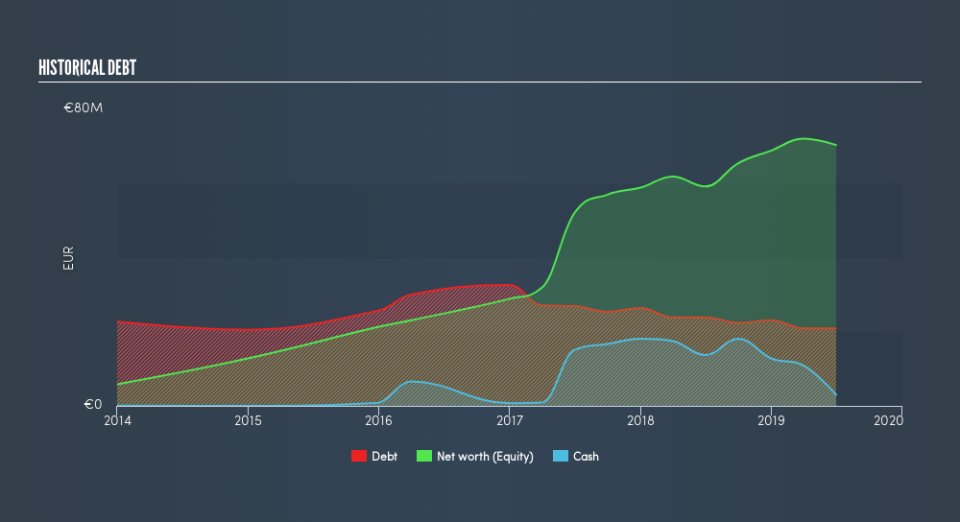Is Kamux Oyj (HEL:KAMUX) A Risky Investment?

Some say volatility, rather than debt, is the best way to think about risk as an investor, but Warren Buffett famously said that 'Volatility is far from synonymous with risk.' When we think about how risky a company is, we always like to look at its use of debt, since debt overload can lead to ruin. We can see that Kamux Oyj (HEL:KAMUX) does use debt in its business. But is this debt a concern to shareholders?
When Is Debt Dangerous?
Debt and other liabilities become risky for a business when it cannot easily fulfill those obligations, either with free cash flow or by raising capital at an attractive price. If things get really bad, the lenders can take control of the business. However, a more usual (but still expensive) situation is where a company must dilute shareholders at a cheap share price simply to get debt under control. Of course, plenty of companies use debt to fund growth, without any negative consequences. The first thing to do when considering how much debt a business uses is to look at its cash and debt together.
View our latest analysis for Kamux Oyj
What Is Kamux Oyj's Net Debt?
You can click the graphic below for the historical numbers, but it shows that Kamux Oyj had €20.9m of debt in June 2019, down from €23.9m, one year before. However, it also had €3.00m in cash, and so its net debt is €17.9m.
How Strong Is Kamux Oyj's Balance Sheet?
We can see from the most recent balance sheet that Kamux Oyj had liabilities of €37.3m falling due within a year, and liabilities of €50.7m due beyond that. Offsetting these obligations, it had cash of €3.00m as well as receivables valued at €19.0m due within 12 months. So its liabilities outweigh the sum of its cash and (near-term) receivables by €66.0m.
While this might seem like a lot, it is not so bad since Kamux Oyj has a market capitalization of €210.5m, and so it could probably strengthen its balance sheet by raising capital if it needed to. However, it is still worthwhile taking a close look at its ability to pay off debt.
We measure a company's debt load relative to its earnings power by looking at its net debt divided by its earnings before interest, tax, depreciation, and amortization (EBITDA) and by calculating how easily its earnings before interest and tax (EBIT) cover its interest expense (interest cover). Thus we consider debt relative to earnings both with and without depreciation and amortization expenses.
Kamux Oyj has a low net debt to EBITDA ratio of only 0.68. And its EBIT covers its interest expense a whopping 24.2 times over. So we're pretty relaxed about its super-conservative use of debt. Another good sign is that Kamux Oyj has been able to increase its EBIT by 22% in twelve months, making it easier to pay down debt. There's no doubt that we learn most about debt from the balance sheet. But it is future earnings, more than anything, that will determine Kamux Oyj's ability to maintain a healthy balance sheet going forward. So if you want to see what the professionals think, you might find this free report on analyst profit forecasts to be interesting.
Finally, a business needs free cash flow to pay off debt; accounting profits just don't cut it. So the logical step is to look at the proportion of that EBIT that is matched by actual free cash flow. In the last three years, Kamux Oyj created free cash flow amounting to 9.2% of its EBIT, an uninspiring performance. For us, cash conversion that low sparks a little paranoia about is ability to extinguish debt.
Our View
When it comes to the balance sheet, the standout positive for Kamux Oyj was the fact that it seems able to cover its interest expense with its EBIT confidently. But the other factors we noted above weren't so encouraging. For instance it seems like it has to struggle a bit to convert EBIT to free cash flow. When we consider all the elements mentioned above, it seems to us that Kamux Oyj is managing its debt quite well. Having said that, the load is sufficiently heavy that we would recommend any shareholders keep a close eye on it. Another positive for shareholders is that it pays dividends. So if you like receiving those dividend payments, check Kamux Oyj's dividend history, without delay!
At the end of the day, it's often better to focus on companies that are free from net debt. You can access our special list of such companies (all with a track record of profit growth). It's free.
We aim to bring you long-term focused research analysis driven by fundamental data. Note that our analysis may not factor in the latest price-sensitive company announcements or qualitative material.
If you spot an error that warrants correction, please contact the editor at editorial-team@simplywallst.com. This article by Simply Wall St is general in nature. It does not constitute a recommendation to buy or sell any stock, and does not take account of your objectives, or your financial situation. Simply Wall St has no position in the stocks mentioned. Thank you for reading.

